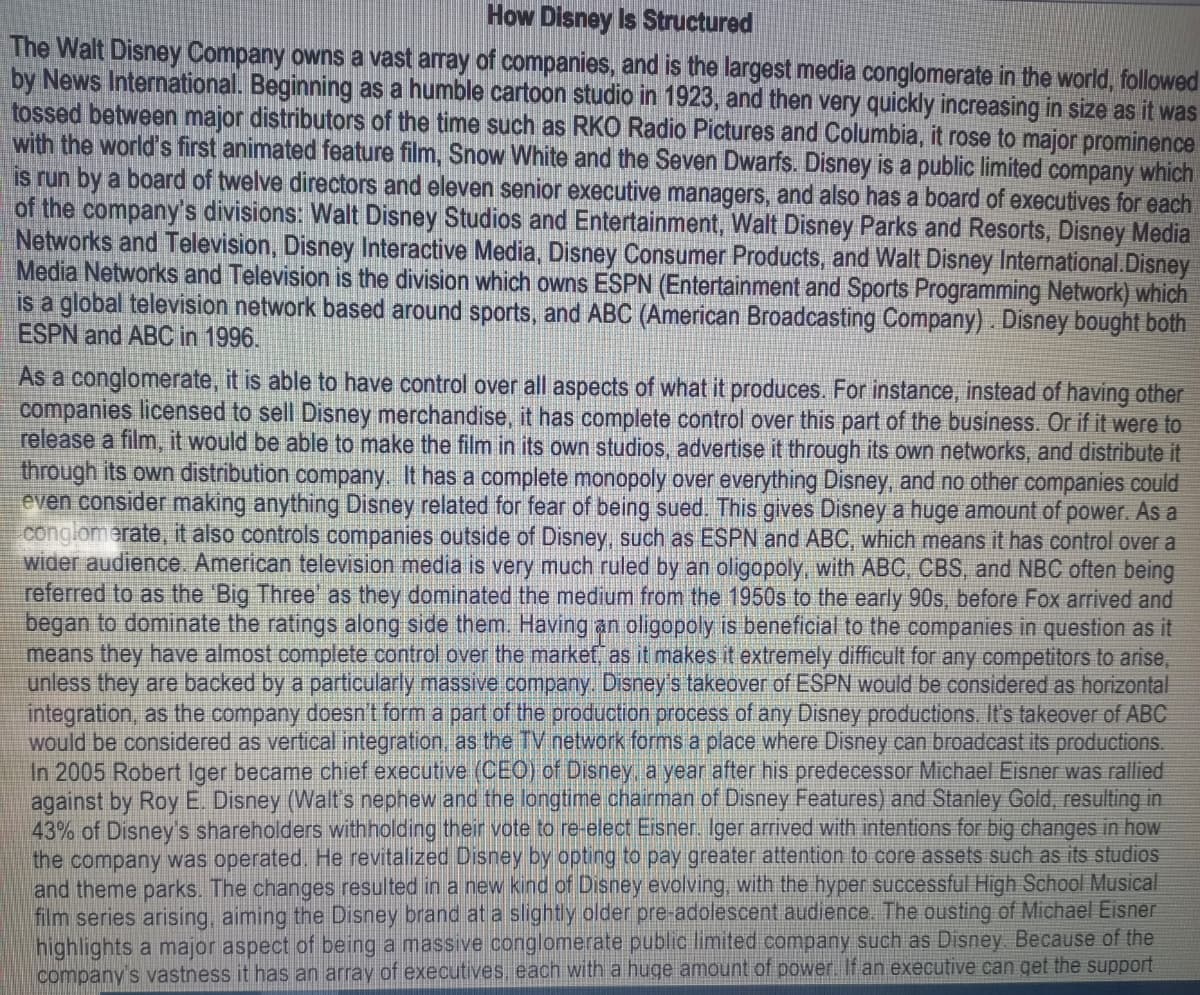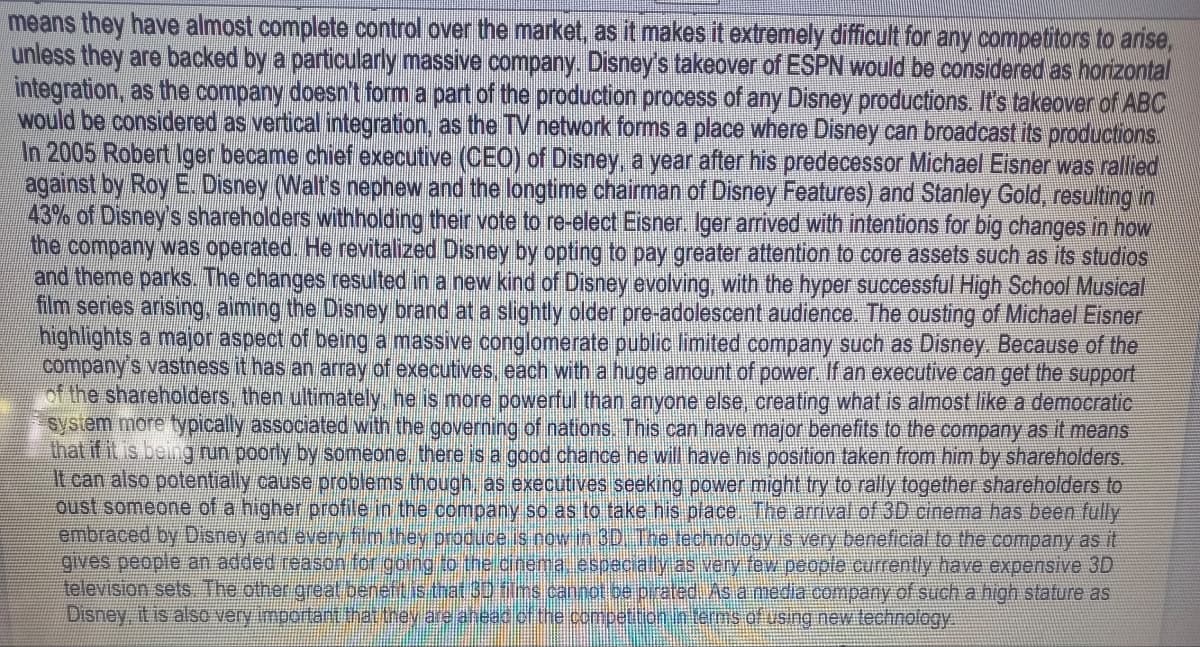Examine Horizontal and Vertical (Forward) Integration as a with appropriate examples. You must discuss the example and explain the relevant outcomes achieved through the Integration.
Examine Horizontal and Vertical (Forward) Integration as a with appropriate examples. You must discuss the example and explain the relevant outcomes achieved through the Integration.
Principles Of Marketing
17th Edition
ISBN:9780134492513
Author:Kotler, Philip, Armstrong, Gary (gary M.)
Publisher:Kotler, Philip, Armstrong, Gary (gary M.)
Chapter1: Marketing: Creating Customer Value And Engagement
Section: Chapter Questions
Problem 1.1DQ
Related questions
Question
Examine Horizontal and Vertical (Forward) Integration as a with appropriate examples. You must discuss the example and explain the relevant outcomes achieved through the Integration.

Transcribed Image Text:How Disney Is Structured
The Walt Disney Company owns a vast array of companies, and is the largest media conglomerate in the world, followed
by News International. Beginning as a humble cartoon studio in 1923, and then very quickly increasing in size as it was
tossed between major distributors of the time such as RKO Radio Pictures and Columbia, it rose to major prominence
with the world's first animated feature film, Snow White and the Seven Dwarfs. Disney is a public limited company which
is run by a board of twelve directors and eleven senior executive managers, and also has a board of executives for each
of the company's divisions: Walt Disney Studios and Entertainment, Walt Disney Parks and Resorts, Disney Media
Networks and Television, Disney Interactive Media, Disney Consumer Products, and Walt Disney International.Disney
Media Networks and Television is the division which owns ESPN (Entertainment and Sports Programming Network) which
is a global television network based around sports, and ABC (American Broadcasting Company). Disney bought both
ESPN and ABC in 1996.
As a conglomerate, it is able to have control over all aspects of what it produces. For instance, instead of having other
companies licensed to sell Disney merchandise, it has complete control over this part of the business. Or if it were to
release a film, it would be able to make the film in its own studios, advertise it through its own networks, and distribute it
through its own distribution company. It has a complete monopoly over everything Disney, and no other companies could
even consider making anything Disney related for fear of being sued. This gives Disney a huge amount of power. As a
conglomerate, it also controls companies outside of Disney, such as ESPN and ABC, which means it has control over a
wider audience. American television media is very much ruled by an oligopoly, with ABC, CBS, and NBC often being
referred to as the 'Big Three' as they dominated the medium from the 1950s to the early 90s, before Fox arrived and
began to dominate the ratings along side them. Having an oligopoly is beneficial to the companies in question as it
means they have almost complete control over the market, as it makes it extremely difficult for any competitors to arise,
unless they are backed by a particularly massive company. Disney's takeover of ESPN would be considered as horizontal
integration, as the company doesn't form a part of the production process of any Disney productions. It's takeover of ABC
would be considered as vertical integration, as the TV network forms a place where Disney can broadcast its productions.
In 2005 Robert Iger became chief executive (CEO) of Disney, a year after his predecessor Michael Eisner was rallied
against by Roy E. Disney (Walt's nephew and the longtime chairman of Disney Features) and Stanley Gold, resulting in
43% of Disney's shareholders withholding their vote to re-elect Eisner. Iger arrived with intentions for big changes in how
the company was operated. He revitalized Disney by opting to pay greater attention to core assets such as its studios
and theme parks. The changes resulted in a new kind of Disney evolving, with the hyper successful High School Musical
film series arising, aiming the Disney brand at a slightly older pre-adolescent audience. The ousting of Michael Eisner
highlights a major aspect of being a massive conglomerate public limited company such as Disney. Because of the
company's vastness it has an array of executives, each with a huge amount of power. If an executive can get the support

Transcribed Image Text:means they have almost complete control over the market, as it makes it extremely difficult for any competitors to arise,
unless they are backed by a particularly massive company. Disney's takeover of ESPN would be considered as horizontal
integration, as the company doesn't form a part of the production process of any Disney productions. It's takeover of ABC
would be considered as vertical integration, as the TV network forms a place where Disney can broadcast its productions.
In 2005 Robert Iger became chief executive (CEO) of Disney, a year after his predecessor Michael Eisner was rallied
against by Roy E. Disney (Walt's nephew and the longtime chairman of Disney Features) and Stanley Gold, resulting in
43% of Disney's shareholders withholding their vote to re-elect Eisner. Iger arrived with intentions for big changes in how
the company was operated. He revitalized Disney by opting to pay greater attention to core assets such as its studios
and theme parks. The changes resulted in a new kind of Disney evolving, with the hyper successful High School Musical
film series arising, aiming the Disney brand at a slightly older pre-adolescent audience. The ousting of Michael Eisner
highlights a major aspect of being a massive conglomerate public limited company such as Disney. Because of the
company's vastness it has an array of executives, each with a huge amount of power. If an executive can get the support
of the shareholders, then ultimately, he is more powerful than anyone else, creating what is almost like a democratic
system more typically associated with the governing of nations. This can have major benefits to the company as it means
that if it is being run poorly by someone, there is a good chance he will have his position taken from him by shareholders.
It can also potentially cause problems though, as executives seeking power might try to rally together shareholders to
oust someone of a higher profile in the company so as to take his place. The arrival of 3D cinema has been fully
embraced by Disney and every film they produce is now in 3D. The technology is very beneficial to the company as it
gives people an added reason for going to the cinema, especially as very few people currently have expensive 3D
television sets. The other great beneft is that 3D films cannot be pirated. As a media company of such a high stature as
Disney, it is also very important that they are ahead of the competition in terms of using new technology.
Expert Solution
This question has been solved!
Explore an expertly crafted, step-by-step solution for a thorough understanding of key concepts.
Step by step
Solved in 3 steps

Recommended textbooks for you

Principles Of Marketing
Marketing
ISBN:
9780134492513
Author:
Kotler, Philip, Armstrong, Gary (gary M.)
Publisher:
Pearson Higher Education,

Marketing
Marketing
ISBN:
9781259924040
Author:
Roger A. Kerin, Steven W. Hartley
Publisher:
McGraw-Hill Education

Foundations of Business (MindTap Course List)
Marketing
ISBN:
9781337386920
Author:
William M. Pride, Robert J. Hughes, Jack R. Kapoor
Publisher:
Cengage Learning

Principles Of Marketing
Marketing
ISBN:
9780134492513
Author:
Kotler, Philip, Armstrong, Gary (gary M.)
Publisher:
Pearson Higher Education,

Marketing
Marketing
ISBN:
9781259924040
Author:
Roger A. Kerin, Steven W. Hartley
Publisher:
McGraw-Hill Education

Foundations of Business (MindTap Course List)
Marketing
ISBN:
9781337386920
Author:
William M. Pride, Robert J. Hughes, Jack R. Kapoor
Publisher:
Cengage Learning

Marketing: An Introduction (13th Edition)
Marketing
ISBN:
9780134149530
Author:
Gary Armstrong, Philip Kotler
Publisher:
PEARSON


Contemporary Marketing
Marketing
ISBN:
9780357033777
Author:
Louis E. Boone, David L. Kurtz
Publisher:
Cengage Learning